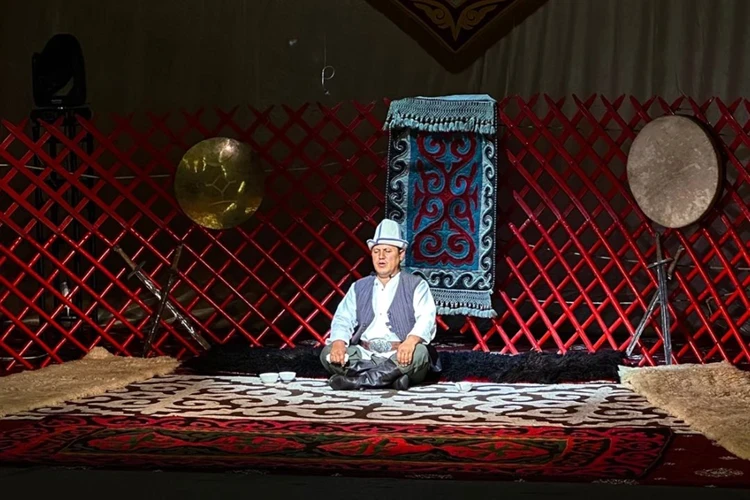
The storyteller of epics, storyteller, manaschi S. Karalaev was born in the village of Semiz-Bel near the wintering grounds of Ak-Olen in the present-day Ton district of the Issyk-Kul region in a poor family.
From the age of 12, he worked as a laborer for local landlords with his father. During the events of 1916, he fled to China; upon returning to his homeland in 1917, he again worked as a laborer for the wealthy. In 1918, he voluntarily joined a detachment of Red Guards and defended Soviet power in Siberia, Almaty, Ashgabat, and Bukhara alongside the Red Army. After the Civil War, he actively participated in building a new life in his homeland.
From 1921 to 1931, he served as the chairman of the Maman and Irdyk village councils in the Karakol district of the Issyk-Kul region. In 1930, at the Institute of Language and Literature under the People's Commissariat of Education of the Kyrgyz ASSR, the epic "Manas" was recorded from his words. In 1936, he was accepted as a soloist — storyteller-manaschi in the Kyrgyz State Philharmonic.
His talent as a storyteller was awakened in early childhood by his grandmother Dakish — a remarkable narrator of folk tales, traditions, and legends. She memorized excerpts from the epic "Manas," which she performed for her grandson, and retold the content of the epic in prose. The capable boy remembered the stories of his grandmother and other famous manaschi. Starting in 1918, S. Karalaev began to perform excerpts from the epic "Manas" himself. In 1924, he met the famous manaschi Choyuke Omurov, with whom he studied the performance of the epic "Manas" for several years. In his memoirs, S. Karalaev also mentions the renowned manaschi Akylbek, who also taught him the art of performance.
From 1925, he performed independently, and from 1930, he became known as an outstanding manaschi. The writer Dzh. Ashubaev and philologist K. Karasaev played a significant role in promoting S. Karalaev's talent. In 1935, the recording of the complete Karalaev variant of the epic "Manas" began. In 1937, the recording of the first part of the trilogy was completed, followed by "Semetei," "Seitek," and the continuation of which included the unknown stories of Kenen, Alimsaryk, and Kulansaryk.
The total volume of this variant of the epic "Manas" amounted to 500,553 poetic lines. It is recognized by literary scholars as the most complete, substantive, and highly artistic version. Compared to the epics of the peoples of the world, it is 20 times larger in volume than Homer's "Iliad" and "Odyssey," 5 times larger than "Shahnameh," and 2 times larger than "Mahabharata," etc. S. Karalaev could perform the epic "Manas" for several months in a row. He is rightly called the Homer of the 20th century. A characteristic feature of the performance of the epic is not the recitation of memorized text, but the individual expression of improvisational and acting skills of each manaschi. For example, the Karalaev variant of the epic "Manas" differs from other versions by the heroic-patriotic optimism of the characters, with less susceptibility of the heroes to religiosity. This specificity of this variant is likely connected to the biography of the storyteller himself, who defended Soviet power with weapons in hand against the White Guards.
From S. Karalaev's words, the epic "Toshstuk" was recorded and published in 1938 in Kyrgyz, and in 1958 in Russian.
He created a number of original works. In 1929, his first book was published — the story "Eryk tazynda" ("At the Dawn of Freedom"). He is the author of tales, poems, and stories published as separate editions.
People's Artist of the Kyrgyz SSR (1939).
Member of the Union of Writers of the USSR since 1938.
Awarded three Orders of the Red Banner of Labor, the Order of the Badge of Honor, and the Medal for Valorous Labor in the Great Patriotic War of 1941-1945.
SEPARATE PUBLICATIONS
in Kyrgyz
Eryk tazynda: Aцгеме, — F.: Kyrgyzmamabas, 1929. — 34 p. At the Dawn of Freedom.
Teshstuk: Epic. — F.: Kazan: Kyrgyzmamabas, 1938. — 386 p.
Kanykeydin jomogu.— F.: Kyrgyzmamabas, 1940.— 108 p. Tales of Kanykey.
Kanykeydin Taitorunu chapkany. — F.: Kyrgyzmamabas, 1941.— 154 p. Taitoru at the competition.
Kanattyu kushlar. — F.: Kyrgyzokuupedmambas, 1955.— 128 p. Winged.
Unutulgus kundar: Zheti suudagy grazhdanskaya sogushdan estelikter. — F.: Kyrgyzmamabas, 1955. — 136 p. Unforgettable Days.
Er Teshstuk. — F.: Kyrgyzmamabas, 1956. — 11 p.
Deldesh batyr: Domok. — F.: Kyrgyzokuupedmambas, 1957. — 88 p. The Hero Deldesh.
Tomor mergen: Yry menen jazylgan jomok. — F.: Kyrgyzmamabas, 1957. — 75 p. Hunter Tomor.
Esten ketpeit: Proza jana yrlard. — F.: Kyrgyzmamabas, 1957. — 109 p. This is not forgotten.
Azapty kep kergen Kubat. — F.: Kyrgyzmamabas, 1958.— 76 p. The Suffering Kubat.
Molodo batyr: Poema. — F.: Kyrgyzmamabas, 1960.— 110 p. The Hero Molodo.
Bakytay balban: El jomogundan. — F.: Kyrgyzmamabas, 1961. — 85 p. The Strongman Bakytay.
Karamoldo: Poema,—F.: Kyrgyzmamabas, 1962.— 80 p.
Taitoru: Manas eposundan uzundu. — F.: Kyrgyzokuupedmambas, 1963, — 120 p.
Burkutchuler zhenunde akgeme. — F.: Kyrgyzstan, 1964.— 44 p. Stories of the hunter with a golden eagle.
Tulparlar. — F.: Mektep, 1965.— 59 p. The Steeds.
Baatyrlard, ayymdard. — F.: Mektep, 1967.— 106 p. Portraits of Heroes and Beauties.
Unutulgus kundar: Estelikter. — F.: Kyrgyzstan, 1967.— 184 p. Unforgettable Days.
Er Teshstuk. — F.: Mektep, 1969. — 331 p.
Semeteydin balalyk chagy. — F.: Mektep, 1970.—67 p. The Childhood of Semetei.
Tulparlar: Yrlard. — F.: Mektep, 1978.— 58 p. The Steeds.
Tulparlar: Yrlard. — F.: Mektep, 1982.— 60 p. The Steeds.
Kanykeydin Taitorunu chapkany: "Manas" eposundan. — F.: Mektep, 1986, —76 p. Taitoru at the competition.
Manas: Epic. — F.: Kyrgyzstan, 1986. — 264 p.
Semetei: Epic. — F.: Kyrgyzstan, 1987. — 286 p.
Baatyrlard: Eposton uzunduler. — F.: Mektep, 1988.—56 p. Heroes.
in Russian
Er Toshstuk. — F.: Kyrgyzgosizdat, 1958. — 210 p.
The Golden Bell. — M.: Detgiz, 1959. — 94 p.















































